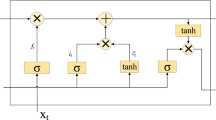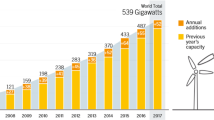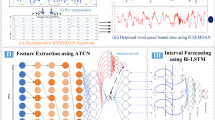Abstract
Aiming at the uncertainty of wind power and the low accuracy of multi-step interval prediction, an ultra-short-term wind power multi-step interval prediction method based on complete ensemble empirical mode decomposition with adaptive noise-fuzzy information granulation (CEEMDAN-FIG) and convolutional neural network-bidirectional long short-term memory (CNN-BiLSTM) is proposed. Firstly, the CEEMDAN is used to decompose the wind power time series into several sub-components to reduce the non-stationary characteristics of the wind power time series. Then, different components are selected for FIG, and the maximum value sequence, average value sequence, minimum value sequence gotten from FIG, and the remaining components without FIG are combined with the wind speed data, wind direction data, and the temperature data. They all are input into the CNN-BiLSTM combined prediction model to obtain the initial wind power prediction interval. The prediction results of the maximum value sequence, the average value sequence, and the minimum value sequence are respectively superimposed on the prediction results of the remaining components to obtain the upper limit, point prediction, and lower limit of the initial prediction interval. Finally, the improved coverage width criterion is used as the objective function to optimize the interval, and the forecast interval of wind power under a given confidence level is generated. Taking the actual operating data of a certain unit of a wind farm as an example, the validity of the proposed model is verified.













Similar content being viewed by others
Data availability
The datasets used or analyzed during the current study are available from the corresponding author on reasonable request.
References
Chen XB(2019) Some research based on machine leaning for wind speed interval prediction. Huazhong University of Science and Technology
Feng SL, Wang WS, Liu C, Dai HZ (2010) Research on the physical methods of wind farm power prediction. Proc Chin Soc Elect Eng 02:1–6. https://doi.org/10.13334/j.0258-8013.pcsee.2010.02.014
He Y Yan Y Xu Q.(2019) Wind and solar power probability density prediction via fuzzy information granulation and support vector quantile regression. International Journal of Electrical Power and Energy Systems(), doi:https://doi.org/10.1016/j.ijepes.2019.05.075.
Kariniotakis GN, Stavrakakis GS, Nogaret EF (1996) Wind power forecasting using advanced neural networks models. IEEE Trans Energy Convers 11(4):762–767. https://doi.org/10.1109/60.556376
Li JH, Huang YJ, Huang Q (2019) Interval prediction method of wind power based on improved chaotic time series. Electric Power Autom Equip 39(05):53–60
Liu RS, Meng XH (2013) ARMA network traffic anomaly detection algorithm with adaptive threshold. J Xinyang Norm Univ nat Sci Ed 02:296–300. CNKI:SUN:XYSK.0.2013-02-036
Luo XJ. (2021). Research on fault diagnosis method of wind turbine transmission system based on deep learning [D]. North China Electric Power University (Beijing), 2021. DOI: https://doi.org/10.27140/d.cnki.ghbbu.2021.000001
National Energy Commission. Grid-connected operation of wind power in 2016 [EB/OL].[2021–2–26]. http://www.nea.gov.cn/2017-01/26/c_136014615.htm
National Energy Commission. Grid-connected operation of wind power in 2017 [EB/OL].[2021–2–26]. http://www.nea.gov.cn/2018-02/01/c_136942234.htm
National Energy Commission. Grid-connected operation of wind power in 2018 [EB/OL].[2021–2–26]. http://www.nea.gov.cn/2019-01/28/c_137780779.htm
National Energy Commission. Grid-connected operation of wind power in 2019 [EB/OL].[2021–2–26]. http://www.nea.gov.cn/2020-02/28/c_138827910.htm
National Energy Commission. Grid-connected operation of wind power in the first half of 2020 [EB/O L].[2021–2–26]. http://www.nea.gov.cn/2020-07/31/c_139254298.htm.
Qiu XP. (2020) Networks and deep learning. Journal of Chinese Information Processing(07), 4.doi:CNKI:SUN:MESS.0.2020–07–001.
Sepp Hochreiter,Jü & rgen Schmidhuber.(1997) Long short-term memory. Neural Computation(8), doi:https://doi.org/10.1162/neco.1997.9.8.1735.
Shen YF. (2019). Research on ultra-short-term forecast of wind power [D]. Nanjing University of Science and Technology, 2019. https://doi.org/10.27241/d.cnki.gnjgu.2019.001429.
Torres ME, Colominas MA, Schlotthauer G et al (2011) A complete ensemble empirical mode decomposition with adaptive noise[C]//2011 IEEE international conference on acoustics, speech and signal processing (ICASSP). IEEE 2011:4144–4147
Xia YF (2020) In 2019, more than 60GW of wind power was installed globally. Wind Power 04:36–41. CNKI:SUN:FENE.0.2020-04-017
Xue Y, Zhang N, Yu ZC et al (2020) Wind power range prediction based on BiLSTM and Bootstrap method [J]. Renew Energy 38(08):1059–1064
Yang Y, Yang L, Lang J, Zhang YY (2017) Research on multi-scenario wind power prediction based on LS-SVM algorithm. Smart Elect Power 07:58–63. CNKI:SUN:XBDJ.0.2017-07-015
Yang M, Chen YL, Wei ZC (2018) Research on real-time wind power prediction based on EEMD denoising and set pair theory. Acta Solar Energy 05:1440–1448. CNKI:SUN:TYLX.0.2018-05-037
Yang M, Yang CL, Dong JC (2019) Research on ultra-short-term probability interval prediction of wind power based on optimization model of prediction error distribution. Acta Energiae Solaris Sinica 40(10):2967–2978. CNKI:SUN:TYLX.0.2019-10-035
Yang XY, Xing GT, Ma X et al (2020) A quantile regression model of nuclear extreme learning machine and interval prediction of wind power. Acta Energiae Solaris Sinica 41(11):300–306. CNKI:SUN:TYLX.0.2020-11-040
Yang XY, Zhang YF, Ye TZ et al (2020) Prediction of combination probability interval of wind power based on naive Bayes. High Voltage Eng 46(3):1096–1105. https://doi.org/10.13336/j.1003-6520.hve.20200331041
Yin H, Zeng Y, Meng AB et al (2018) Wind speed multi-step interval prediction based on singular spectrum analysis-fuzzy information granulation and extreme learning machine. Power Syst Technol 42(05):1467–1474. https://doi.org/10.13335/j.1000-3673.pst.2017.2589
Yin H, Huang SQ, Liu Z et al (2019) Short-term wind speed prediction based on fuzzy information granulation and LSTM. Electric Meas Instrum 56(11):101–107. https://doi.org/10.19753/j.issn1001-1390.2019.11.017
Zeng Y, Yin H, Liu Z (2018) Wind speed multi-step interval prediction based on EWT-FIG and ORELM model. Ningxia Electric Power 04:6–13. CNKI:SUN:NXDL.0.2018-04-003
Zhang FC (2021) Research and application of wind power prediction technology based on deep learning [D]. University of Chinese Academy of Sciences (Shenyang Institute of Computing Technology, Chinese Academy of Sciences). https://doi.org/10.27587/d.cnki.gksjs.2021.000019
Zhang JH Feng Y Huang YW Yan J.(2021). Wind farm unit group power prediction based on EMD-RVM. Distributed Energy (02), 22–31. https://doi.org/10.16513/j.2096-2185.DE.2106026.
Zhao Z, Wang XS, Qiao JT (2019) Ultra-short-term wind speed prediction based on VMD and improved ARIMA model. J North China Elect Power Univ nat Sci Ed 01:54–59. CNKI:SUN:HBDL.0.2019-01-008
Zhao Z, Nan HG, Qiao JT (2020) Research on improved time series ultra-short-term wind speed prediction based on quadratic decomposition. J North China Elect Power Univ nat Sci Ed 04:53–60. CNKI:SUN:HBDL.0.2020-04-007
Zhao Z Wang XS. (2020). Ultra-short-term wind power multi-step prediction based on CEEMD and improved time series model. Act Solar Energy(07),352–358. doi:CNKI:SUN:TYLX.0.2020–07–047.
Funding
This study was funded by the Fundamental Research Funds for the Central Universities (2017MS133), the General Project of Beijing Municipal Natural Science Foundation (3202027), and the Shenzhen Science and Technology Plan Project (KCXFZ20201221173402007).
Author information
Authors and Affiliations
Contributions
Zheng Zhao: conceptualization, methodology. Honggang Nan: methodology, performed the experiments. Zihan Liu and Yuebo Yu: writing review and editing.
Corresponding author
Ethics declarations
Ethics approval and consent to participate
Not applicable.
Consent for publication
Not applicable.
Competing interests
The authors declare no competing interests.
Additional information
Responsible Editor: Philippe Garrigues
Publisher's note
Springer Nature remains neutral with regard to jurisdictional claims in published maps and institutional affiliations.
Rights and permissions
About this article
Cite this article
Zhao, Z., Nan, H., Liu, Z. et al. Multi-step interval prediction of ultra-short-term wind power based on CEEMDAN-FIG and CNN-BiLSTM. Environ Sci Pollut Res 29, 58097–58109 (2022). https://doi.org/10.1007/s11356-022-19885-6
Received:
Accepted:
Published:
Issue Date:
DOI: https://doi.org/10.1007/s11356-022-19885-6




